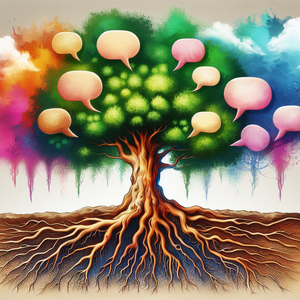Beyond the Bullet Points: Transforming Your Resume with Storytelling

Storytelling is innately human. It’s how we make sense of the world, connect with others, and communicate ideas. When you apply storytelling principles to your resume, you move beyond listing responsibilities and achievements to crafting a narrative that engages recruiters and differentiates you from other candidates. Let’s explore the main advantages of resume storytelling: 1. It Humanizes Your Experience: A resume often feels impersonal, focusing solely on hard facts—job titles, dates, and keywords. Storytelling allows you to inject personality and context into your professional history, showing not just what you’ve done but why it matters. For example, instead of simply stating, “Managed a team of 15,” you can describe how your leadership transformed team performance or solved a pressing problem. 2. It Highlights Your Career Evolution: Rather than presenting your career as fragmented roles, storytelling connects the dots, offering a cohesive narrative of growth. It can show how one role built upon another, how you’ve adapted to challenges, and how your experiences have prepared you for the job you’re seeking. 3. It Communicates Your “Why”: In today’s job market, employers want more than just skills—they want to understand what drives you. Storytelling helps convey your motivations, passions, and values, which are often the deciding factors in hiring decisions. When you explain why you pursued a particular role or industry, you reveal the human side of your professional journey. 4. It Emphasizes Transferable Skills: For career changers or those entering new fields, storytelling enables you to bridge the gap between past experiences and future aspirations. By framing your skills in the context of a narrative, you can show how your past achievements are relevant to new opportunities, making your case more compelling.
Building a Storytelling Framework for Your Resume
Integrating storytelling into your resume doesn’t mean turning it into a novel. The key is to strike a balance between professionalism and creativity, structuring your narrative in a way that is clear, concise, and engaging. Here’s how to get started: 1. Start with a Compelling Summary: Your resume summary is effectively the opening chapter of your career story. Use it to capture attention and set the tone for the rest of the document. Instead of a generic statement like, “Experienced professional seeking new opportunities,” craft something that reflects both your skills and your personality. For example: "As a data-driven marketer with a passion for storytelling, I’ve spent the last seven years transforming raw analytics into actionable strategies that drive brand engagement. I thrive on connecting creativity with measurable impact, making me a valuable partner in achieving business growth." This summary not only highlights skills but also reveals the candidate’s unique approach and enthusiasm for their work. 2. Use the CAR Framework for Achievements: Each job in your career history is a chapter in your larger story. To make these chapters engaging, use the CAR framework (Challenge-Action-Result) to describe your accomplishments: Challenge: What problem or opportunity did you face? Action: What did you do to address it? Result: What was the outcome, and how did it create value? For example: Task-based: “Led a team to improve customer retention.” Story-based: “Faced with declining customer retention rates, I spearheaded a loyalty program initiative, resulting in a 35% increase in repeat customers within one year.” The second version is not only more specific but also conveys the problem-solving process and the impact of the candidate’s efforts. 3. Identify Overarching Themes: Every career has a central thread—whether it’s innovation, leadership, collaboration, or adaptability. Identify yours and weave it throughout your resume. This creates a cohesive narrative that highlights your professional identity. For instance, if your career has revolved around solving complex problems, ensure your achievements reflect that theme. 4. Incorporate Transferable and Emerging Skills: If you're pivoting to a new industry or job function, storytelling can bridge the gap between your past and future. For example, a teacher transitioning into corporate training might frame their skills like this: "As a former educator with over a decade of experience, I excel at designing engaging learning experiences that simplify complex concepts. I’m now leveraging this expertise to create dynamic employee training programs that drive performance and retention." This not only highlights transferable skills but also positions the candidate as future-focused. 5. Add a Personal Touch: While professionalism is key, don’t shy away from letting your personality shine. Briefly mentioning a passion project, volunteer experience, or unique skill can make your resume memorable. For example: "My passion for sustainability extends beyond work, as I lead community initiatives focused on waste reduction and green living. This commitment fuels my drive to create environmentally-conscious business solutions." This adds depth and allows recruiters to see you as a multifaceted individual.
Real-World Examples of Storytelling Resumes
Example 1: The Career Changer Before: “Handled customer complaints and managed escalations.” After: “Turned challenging customer interactions into opportunities for brand loyalty, resolving escalated issues with empathy and efficiency. This approach contributed to a 15% improvement in customer satisfaction scores over two quarters.” This reframes routine tasks as impactful actions aligned with measurable results. Example 2: The Emerging Professional Before: “Assisted with marketing campaigns.” After: “Collaborated on the launch of a multi-channel marketing campaign targeting Gen Z audiences, contributing fresh insights that increased campaign engagement by 20%.” This showcases initiative and demonstrates contribution to a tangible outcome.
In a job market where first impressions are everything, transforming your resume into a compelling narrative can set you apart from the competition. Storytelling allows you to go beyond the bullet points, showcasing not just what you’ve done but who you are and what you’re capable of achieving. By crafting a resume that highlights your career evolution, transferable skills, and personal motivations, you create a document that resonates on both a professional and emotional level. Recruiters are no longer just scanning a list of qualifications—they’re connecting with your story and envisioning how you can add value to their team. So, the next time you sit down to update your resume, think beyond the bullet points. Ask yourself: What’s the story I want to tell? Then, let that narrative guide you as you craft a resume that’s as memorable as it is meaningful.
Resume Consultant / Career Strategist
Career coaching firms, recruitment agencies, or freelance opportunities
Job Responsibilities
Help clients reframe their professional experiences into compelling narratives that align with their career goals.
Conduct in-depth consultations to identify unique achievements, transferable skills, and overarching career themes.
Develop customized resumes, cover letters, and LinkedIn profiles that emphasize storytelling techniques to highlight value.
Unique Skill
Expertise in storytelling frameworks like CAR (Challenge-Action-Result) and professional branding.
Content Marketing Specialist (Career Services)
Career-focused platforms (e.g., LinkedIn, Glassdoor), marketing agencies, or educational institutions
Job Responsibilities
Craft engaging blog posts, eBooks, and social media content on career development topics such as resume writing, job searching, and personal branding.
Use data-driven insights to create content that resonates with job seekers and professionals looking to advance their careers.
Collaborate with career coaches and HR professionals to ensure content aligns with industry trends and practices.
Unique Skill
Proficiency in blending storytelling with SEO strategies to drive organic traffic.
Learning and Development Specialist
Corporate HR departments, consulting firms, or training providers
Job Responsibilities
Design training programs and workshops on professional storytelling, personal branding, and career growth strategies.
Use storytelling frameworks to help employees articulate their value in performance reviews, promotions, and internal job applications.
Partner with HR and leadership teams to align training initiatives with organizational goals.
Unique Skill
Ability to translate abstract storytelling concepts into actionable career development tools for team members.
Personal Branding Consultant
Self-employed consultants or branding agencies
Job Responsibilities
Guide professionals in building a consistent and authentic personal brand across resumes, LinkedIn profiles, and professional portfolios.
Develop multimedia strategies, including video resumes and storytelling-driven presentations, to showcase clients’ unique value propositions.
Stay up-to-date with hiring trends to tailor branding strategies that resonate with decision-makers in specific industries.
Unique Skill
Expertise in merging digital marketing tactics with career branding principles.
HR Business Partner (Talent Development Focus)
Mid-to-large corporations with robust HR strategies (e.g., Google, Deloitte, IBM)
Job Responsibilities
Work with employees to craft career narratives that highlight their contributions during performance evaluations and succession planning.
Coach managers in using storytelling to articulate team achievements and advocate for organizational growth.
Analyze workforce trends to identify areas where storytelling can enhance internal mobility and engagement.
Unique Skill
Advanced interpersonal skills to balance storytelling with data-driven talent metrics.


